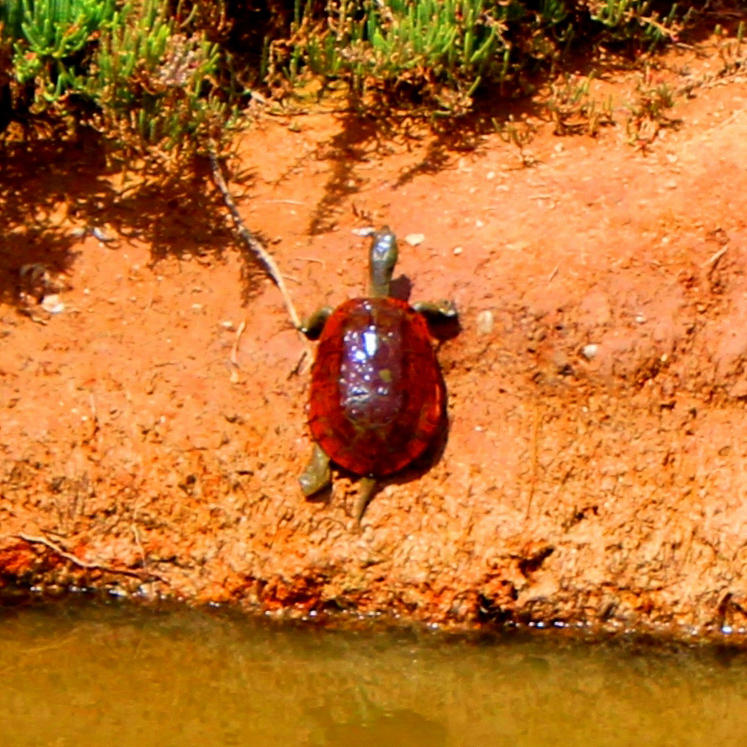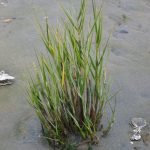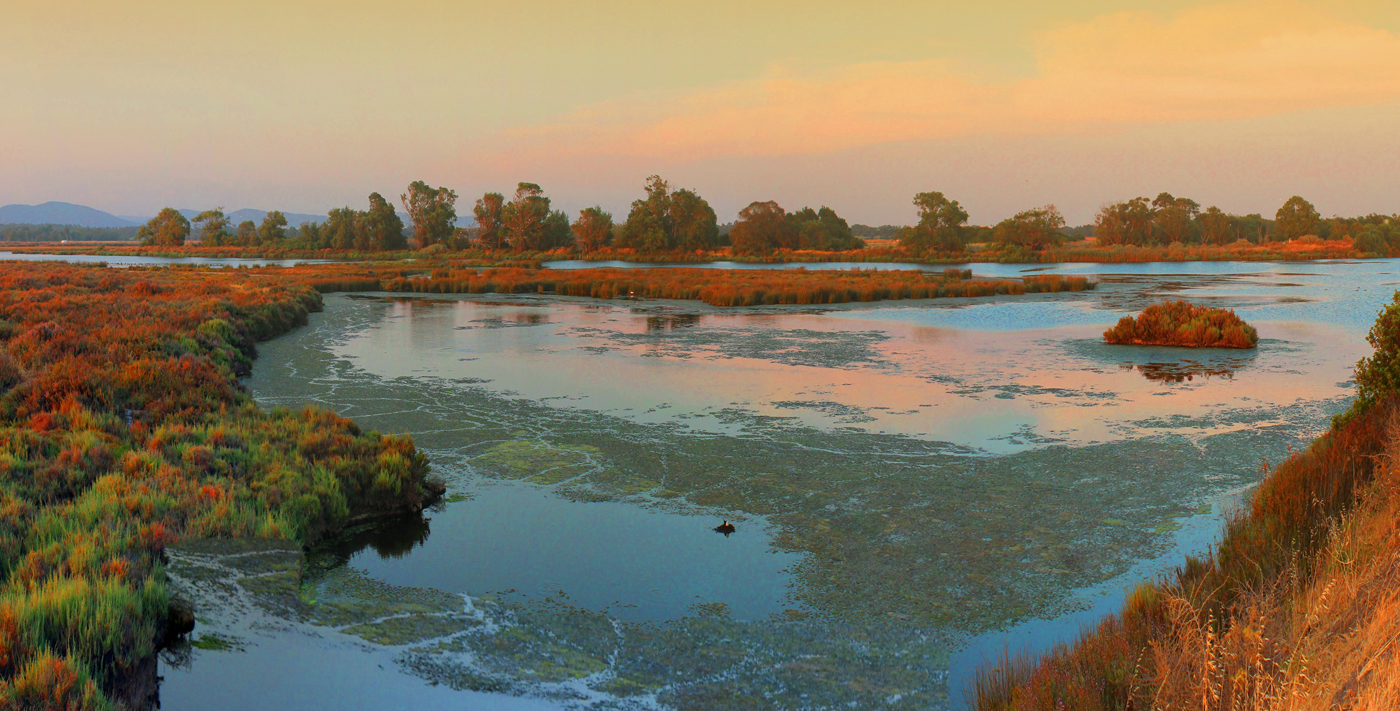• Osprey (Pandion haliaetus) Sep. -Apr. / other months, rare 2)
• Booted Eagle (Hieraaetus pennatus) autumn-winter 3)
• Purple Heron (Ardea purpurea) Mar. -Apr. / Sep. -Oct. 4)
• Black-shouldered Kite (Elanus caeruleus) resident; scarce 5)
• Eurasian Spoonbill (Platalea leucorodia) resident 6)
• Black-winged Stilt (Himantopus himantopus) resident 7)
• Red-knobbed Coot (Fulica cristata) winter; rare 8)
• Spotless Starling (Sturnus unicolor) resident 9)
• Common Waxbill (Estrilda astrild) resident 10)
• Little Stint (Calidris minuta) Sep.-Feb.
• Black Kite (Milvus migrans) Mar.-Aug.
• Pallid Swift (Apus pallidus) Mar.-Oct.
• White Stork (Ciconia ciconia) resident
• Black Tern (Chlidonias niger) relatively rare; summer
• Red-necked Nightjar (Caprimulgus ruficollis) Apr. -Sep.
• Pied Avocet (Recurvirostra avosetta) resident
• Kentish Plover (Charadrius alexandrinus) resident
• Crag Martin (Ptyonoprogne rupestris) resident
• Sardinian Warbler (Sylvia melanocephala) resident
• Great Reed-warbler (Acrocephalus arundinaceus) Mar. -Aug.
• Iberian Azure-winged Magpie (Cyanopica cooki) resident
• Grey Heron (Ardea cinerea) resident
• Cetti’s Warbler (Cettia cetti) resident
• Serin ( Serinus serinus) resident
• Eurasian Reed-warbler: Acrocephalus scirpaceus; •—- Knot: Calidris canutus; •—- Little Tern: Sterna albifrons; •—- Bar-tailed Godwit: Limosa lapponica; •—- Black-headed Gull: Larus ridibundus; •—- Black-tailed Godwit: Limosa limosa; •—- Cattle Egret: Bubulcus ibis; •—- Common Coot: Fulica atra; •—- Common Greenshank: Tringa nebularia; •—- Common Kingfisher: Alcedo atthis; •—- Common Moorhen: Gallinula chloropus; •—- Common Pochard: Aythya ferina; •—- Common Redshank: Tringa totanus; •—- Common Snipe: Gallinago gallinago; •—- Common Teal: Anas crecca; •—- Curlew: Numenius arquata; •—- Eurasian Wigeon: Anas penelope; •—- European Stonechat: Saxicola rubicola (torquatus); •—- Gadwall: Anas strepera; •—- Great Cormorant: Phalacrocorax carbo; •—- Great Crested Grebe: Podiceps cristatus; •—- Grey Plover: Pluvialis squatarola; •—- Little Egret: Egretta garzetta; •—-Little Grebe: Tachybaptus ruficollis; •—- Mallard: Anas platyrhynchos; •—- Meadow Pipit: Anthus pratensis; •—- Mediterranean Gull: Larus melanocephalus; •—- Mistle Thrush: Turdus viscivorus; •—- Northern Shoveler: Anas clypeata; •—- Red-crested Pochard: Netta rufina; •—- Tufted Duck: Aythya fuligula; •—- Water Rail: Rallus aquaticus
 Mediterranean Turtle (Mauremys leprosa): a native species from Iberia and northern Africa, this omnivorous terrapin inhabits shallow and calm freshwater bodies with abundant vegetation cover and sunny banks. Females usually produce two clutches of one to thirtheen eggs. The oldest wild animal documented was 35 years old. This shy animal is relatively easy to find, both in Ludo and in Quinta do Lago, despite being considered ‘vulnerable’ by the IUCN. The main threats faced by this rapidly dwindling species are habitat alteration, marsh drainage, industrial and agricultural pollution, aquifer water extraction and fisheries bycatch. Its shells are also used in the manufacture of tourist souvenirs in Morocco. Being a protected space, Ria Formosa is a safe haven for the Mediterranean Turtle. However, competition from introduced turtles, like the Pond Slider (Trachemys scipta) and the Painted Turtle (Chrysemys picta) has also been suggested as a major long-term threat.
Mediterranean Turtle (Mauremys leprosa): a native species from Iberia and northern Africa, this omnivorous terrapin inhabits shallow and calm freshwater bodies with abundant vegetation cover and sunny banks. Females usually produce two clutches of one to thirtheen eggs. The oldest wild animal documented was 35 years old. This shy animal is relatively easy to find, both in Ludo and in Quinta do Lago, despite being considered ‘vulnerable’ by the IUCN. The main threats faced by this rapidly dwindling species are habitat alteration, marsh drainage, industrial and agricultural pollution, aquifer water extraction and fisheries bycatch. Its shells are also used in the manufacture of tourist souvenirs in Morocco. Being a protected space, Ria Formosa is a safe haven for the Mediterranean Turtle. However, competition from introduced turtles, like the Pond Slider (Trachemys scipta) and the Painted Turtle (Chrysemys picta) has also been suggested as a major long-term threat.
 Small Cordgrass (Spartina maritima): Ria Formosa would not be properly formed without the seemingly humble Small Cordgrass. Besides being the dominant producer of biomass along the lower salt marsh – and salt marshes are one of the most productive ecosystems on the planet – the species also promotes the gradual build-up of rich sediment layers by dampening the water flow, and it also protects the mudflats from erosion, which in turn leads both to the vertical accretion of solid matter within the intertidal zone, and to the establishment of a rich and prospering habitat where juvenile fishes grow up before heading out to the open sea. The plant is under threat from the closely related Spartina anglica, probably one of the most reprehensible British creations ever conceived alongside Morris Marina cars. Image: Miguel Alcántara
Small Cordgrass (Spartina maritima): Ria Formosa would not be properly formed without the seemingly humble Small Cordgrass. Besides being the dominant producer of biomass along the lower salt marsh – and salt marshes are one of the most productive ecosystems on the planet – the species also promotes the gradual build-up of rich sediment layers by dampening the water flow, and it also protects the mudflats from erosion, which in turn leads both to the vertical accretion of solid matter within the intertidal zone, and to the establishment of a rich and prospering habitat where juvenile fishes grow up before heading out to the open sea. The plant is under threat from the closely related Spartina anglica, probably one of the most reprehensible British creations ever conceived alongside Morris Marina cars. Image: Miguel Alcántara
